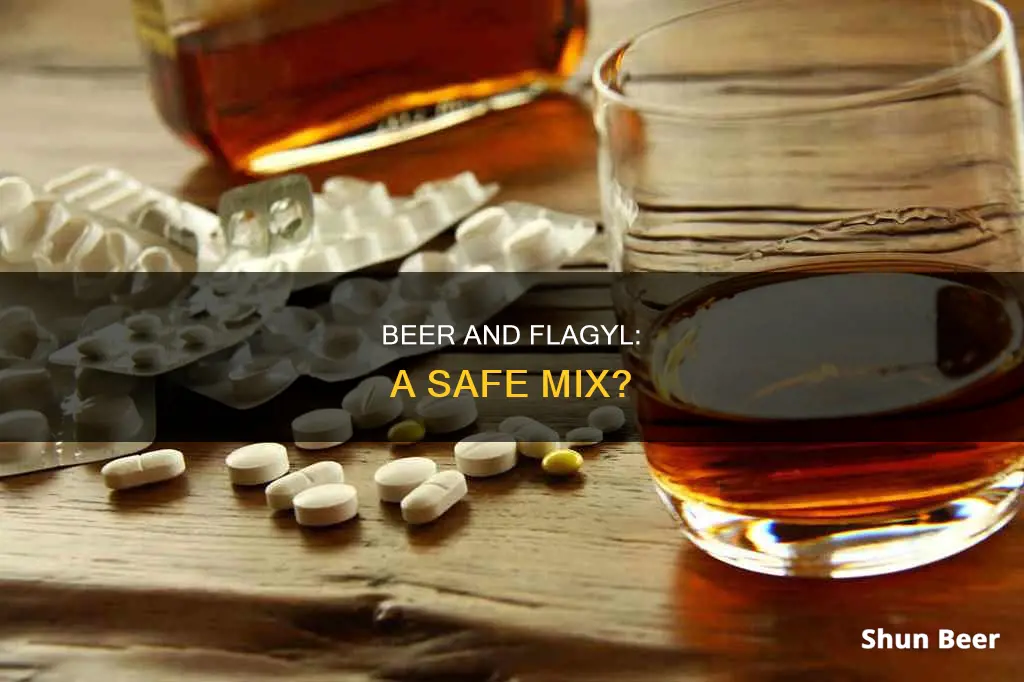
Flagyl, also known as Metronidazole, is a common antibiotic used to treat bacterial infections. It is widely prescribed for infections of the stomach, skin, vagina, and respiratory tract. While on this medication, it is strongly recommended to avoid alcohol, as the combination of the two can lead to a range of adverse reactions, from uncomfortable to severe. The possible side effects of mixing Flagyl and alcohol include flushing, headaches, nausea, vomiting, stomach cramps, rapid heart rate, liver damage, and in extreme cases, even death. The exact mechanism behind these reactions is still a subject of debate, with some studies questioning the strength of the interaction. However, due to the potential risks, healthcare professionals advise abstaining from alcohol during and for a few days after completing the course of Flagyl.
| Characteristics | Values |
|---|---|
| Safety | Mixing Flagyl and alcohol may not be safe and can cause serious side effects |
| Recommendations | Healthcare professionals recommend avoiding alcohol entirely while using the medication and for up to 3 days after the last dose |
| Side effects | Tingling hands and feet, face flushing, throbbing in head and neck, difficulty breathing, dropping blood pressure, heart attack or heart failure, loss of consciousness, headaches, nausea, vomiting, and stomach cramps |
| Fatality | There has been one reported death associated with the disulfiram-like reaction |
| Disulfiram-like reaction | A reaction that occurs when Flagyl and alcohol are combined, similar to the effects of Antabuse, a drug that treats alcoholism |
What You'll Learn

Mixing Flagyl and alcohol can cause a disulfiram-like reaction
Flagyl, also known as Metronidazole, is an antibiotic that treats a wide range of infections, including abdominal, bone and joint, central nervous system, respiratory, and sexually transmitted infections (STIs). It is also available in the form of a cream, gel, and lotion to treat rosacea and bacterial vaginosis.
- Flushing of the face
- Headaches
- Nausea
- Vomiting
- Chest and abdominal discomfort
- Dizziness
- Rapid heart rate
- Liver damage
- Drop in blood pressure
It is important to note that not everyone will experience these side effects, but since doctors cannot determine an individual's risk, it is recommended to avoid consuming alcohol while taking Flagyl. The interaction between Flagyl and alcohol can last for up to 3 days after the last dose of the medication. Therefore, it is generally advised to refrain from alcohol for at least 3 days after completing the Flagyl treatment.
Beer and Vertigo: A Surprising Connection
You may want to see also

The reaction can be fatal
Drinking alcohol while taking Flagyl (Metronidazole) can cause a disulfiram-like reaction in some people. This reaction can be dangerous and even fatal.
Flagyl is an antibiotic that treats many infections, including abdominal, skin, vaginal, and respiratory infections. It is available in various forms, such as tablets, vaginal suppositories, creams, gels, and lotions. While Flagyl itself can cause side effects such as tingling hands and feet, diarrhoea, and mood swings, mixing it with alcohol can lead to more severe consequences.
The disulfiram-like reaction occurs because Flagyl blocks the enzyme aldehyde dehydrogenase, which is responsible for breaking down acetaldehyde, a toxic compound produced when the body metabolises alcohol. As a result, acetaldehyde can accumulate in the bloodstream, leading to a range of symptoms, including flushing of the face, throbbing in the head and neck, nausea, vomiting, stomach cramps, and headaches. This reaction can be particularly dangerous for people with a history of seizures, as Flagyl can lower the seizure threshold.
In rare cases, the combination of Flagyl and alcohol can lead to a sudden drop in blood pressure, rapid heart rate, liver damage, heart attack, heart failure, and even death. These severe side effects highlight the importance of avoiding alcohol while taking Flagyl and for at least 72 hours after the last dose.
While not everyone may experience these negative reactions, it is challenging for doctors to determine an individual's risk. Therefore, it is crucial to follow the recommendations and avoid consuming any alcohol during and for a few days after finishing the medication to minimise the risk of harmful interactions.
Dogs and Beer: What's Safe for Your Pet?
You may want to see also

Side effects of Flagyl include tingling hands and feet
Flagyl, also known as Metronidazole, is a common antibiotic used to treat a variety of bacterial infections. It is available as an oral tablet, a vaginal suppository, and a topical cream. It is important to note that Flagyl should not be mixed with alcohol as it can cause a range of side effects, some of which can be severe or even fatal.
One of the possible side effects of taking Flagyl is tingling hands and feet. This side effect can be unpleasant, and consuming alcohol while experiencing it may lead to additional adverse reactions. It is generally recommended tosection sign alcohol for at least 72 hours after completing a course of Flagyl treatment to avoid any potential interactions.
The combination of Flagyl and alcohol can lead to a disulfiram-like reaction, similar to the effects of Antabuse, a drug used to treat alcoholism. This reaction can cause a range of mild to moderate side effects, including flushing of the face, headaches, nausea, vomiting, and stomach cramps. In rare cases, more severe side effects such as a rapid heart rate, a sudden drop in blood pressure, liver damage, heart attack, or heart failure may occur.
It is worth noting that not everyone will experience negative reactions when combining alcohol and Flagyl. However, due to the potential risks, healthcare professionals advise avoiding alcohol entirely while using Flagyl and for a few days after completing the course. This is especially important for individuals with a history of seizures, as Flagyl can lower the seizure threshold, and alcohol consumption may further increase the risk.
If you aresection sign alcohol while taking Flagyl, it is important to monitor your body's reaction and seek medical advice if necessary. It is also crucial to complete the full course of Flagyl treatment, even if you start to feel better, to prevent complications with infections becoming resistant to the medication.
Alligators and Beer: A Drinking Buddy?
You may want to see also

Alcohol lowers a person's seizure threshold
Drinking alcohol while taking Flagyl (also known as Metronidazole) is not recommended by healthcare professionals. Flagyl is an antibiotic that treats many types of infections, and mixing it with alcohol can have serious health consequences. People are advised to avoid alcohol for up to 3 days after the last dose of Flagyl.
Now, let's discuss the statement, "Alcohol lowers a person's seizure threshold."
Alcohol consumption, especially in excessive amounts, can indeed lower a person's seizure threshold. This means that drinking alcohol can increase the likelihood of experiencing a seizure. This is particularly relevant for individuals with epilepsy or a history of seizures. Let's delve into the details and explore the direct effects of alcohol on seizure thresholds.
Firstly, it's important to understand the concept of a seizure threshold. This refers to the level of brain excitation required to trigger a seizure. In simpler terms, it's like a threshold or barrier that prevents seizures from occurring. When this threshold is lowered, it becomes easier for seizures to be induced. Alcohol has the effect of reducing this protective barrier, making seizures more likely to occur.
The relationship between alcohol and seizures is complex. While small amounts of alcohol may not directly cause seizures in most people, the risk increases significantly with heavier drinking. Binge drinking and alcohol withdrawal are particularly dangerous in this regard, as they can lead to status epilepticus, a life-threatening condition.
During alcohol withdrawal, the body experiences a sudden absence of alcohol's suppressive effects on the central nervous system. This abrupt change can lead to hyperexcitability in the brain, making seizures more likely. This is why withdrawal seizures are a significant concern for individuals with a history of alcohol abuse.
Additionally, alcohol interacts with some seizure medications, reducing their effectiveness. As a result, individuals taking these medications may experience increased seizure activity when consuming alcohol. It's crucial for anyone taking seizure medications to consult their doctor or healthcare team about the safety of drinking alcohol.
In summary, alcohol lowers a person's seizure threshold by increasing brain excitability and interacting with certain medications. This effect is particularly prominent during alcohol withdrawal and can lead to serious health risks, especially for individuals with epilepsy or a history of seizures. It's important to seek medical advice to make informed decisions regarding alcohol consumption and to prioritize the treatment of alcohol dependence over the prevention of seizures.
Beer and High Cholesterol: What's the Verdict?
You may want to see also

Flagyl is an antibiotic that treats many infections
Flagyl, or metronidazole, is an antibiotic that treats many infections. It is a common and affordable medication that can be used to treat a variety of bacterial infections, including abdominal, skin, bone and joint, central nervous system, respiratory, and heart infections, as well as sexually transmitted infections (STIs) such as bacterial vaginosis. It is available in several forms, including oral tablets, vaginal suppositories, creams, gels, and lotions.
When used as directed, Flagyl can be an effective treatment for these infections. However, it is important to follow the prescribed instructions and avoid alcohol consumption while taking this medication. Mixing Flagyl and alcohol can lead to a disulfiram-like reaction, which can cause severe physical side effects. This reaction is similar to the effects of Antabuse, a drug used to treat alcoholism by making patients highly sensitive to alcohol consumption.
The side effects of mixing Flagyl and alcohol can range from uncomfortable to severe and even fatal. Some common side effects include flushing, headaches, nausea, vomiting, stomach cramps, tingling hands and feet, mood swings, light sensitivity, coordination and concentration problems, and flu-like symptoms. More severe side effects can include a sudden drop in blood pressure, rapid heart rate, liver damage, difficulty breathing, heart attack, heart failure, and loss of consciousness.
It is recommended to avoid alcohol for at least 72 hours or three days after the last dose of Flagyl. This is because the interaction between Flagyl and alcohol can continue for up to three days after the medication is stopped. It is also important to note that negative reactions can occur even if alcohol is consumed several hours after taking Flagyl or the next day. Therefore, it is best to wait at least 72 hours after the last dose before consuming alcohol.
In summary, Flagyl is an antibiotic that treats many infections, but it is important to avoid alcohol consumption while taking this medication to prevent dangerous side effects and health consequences.
Beer and Furosemide: Is It Safe to Mix?
You may want to see also
Frequently asked questions
No, it is not recommended to consume alcohol while taking Flagyl. Drinking alcohol while on this medication can cause a disulfiram-like reaction, which can be severe or even fatal.
When a person consumes alcohol, the body breaks it down into a compound called acetaldehyde, which is toxic and causes unwanted side effects. The body then reduces acetaldehyde to acetate with the help of an enzyme. Flagyl blocks the effects of this enzyme, leading to a buildup of acetaldehyde in the bloodstream. This can cause various symptoms, including flushing, nausea, vomiting, headaches, and in severe cases, a rapid heart rate or a sudden drop in blood pressure.
It is recommended to wait for at least 72 hours (3 days) after the last dose of Flagyl before consuming alcohol.
The side effects of mixing Flagyl and alcohol can range from mild to severe and include flushing, headaches, nausea, vomiting, stomach cramps, throbbing in the head and neck, difficulty breathing, a sudden drop in blood pressure, heart attack or heart failure, and loss of consciousness.







